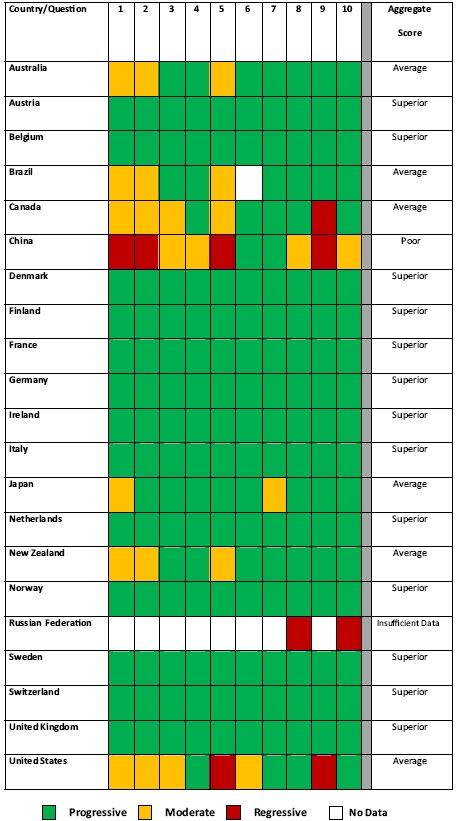Published in Comprehensive Reviews in Food Science and Food Safety, the report evaluates and compares the traceability regulations of 21 Organization for Economic Co-Operation and Development (OECD) countries – finding that EU countries ranked highest when it comes to global food traceability regulations and requirements.
According to the report, which ranked each country based on aggregated responses to a series of questions developed to assess their traceability policies and programs, EU member states and the European Free Trade Association (EFTA) countries of Norway and Switzerland, all scored as ‘Superior’.
“While there are a variety of benefits to global trading of food items, there are also many complications, particularly when it comes to tracing products internationally in the event of foodborne illness, animal or plant disease, or product recall,” said Professor Sylvain Charlebois at the University of Guelph, one of the authors of the report. “This report provides a comparative assessment to aid in discussions concerning harmonization of food traceability requirements and where countries can continue to focus on improvements.”
According to the report, Australia, Canada, Japan, Brazil, New Zealand, and the United States received an overall ranking score of ‘Average’, while China received an overall world ranking of ‘Poor’. Data from the Russian Federation was insufficient, so it was not ranked, said the team.
“It would be very beneficial for global markets if countries would move toward the development of an interoperable and uniform global traceability system by following the examples of the EU, and developing uniform requirements for electronic identification, database systems, and interoperability coupled with and supported by globally recognized identification standards and auditing schemes,” concluded the team.
Testing traceability
The authors behind the report evaluated and ranked each country based on aggregated responses to a series of questions developed to assess their traceability policies and programs. The questions asked whether mandatory traceability regulations exist at the national level; if regulations include imported products, and the nature of required documentation for imports; if an electronic database for traceability exists and if present, its accessibility; and if labelling regulations allow consumer access to help their understanding of traceability.
The examination ranked the countries that have specific traceability regulations for all commodities, both domestic and imports, as ‘Progressive’, while countries with less broad or stringent regulations were ranked as ‘Moderate’, and countries that were still in the developmental stage of mandatory or industry-led traceability requirements were ranked as ‘Regressive’.
Aggregate scores were then developed from all of the rankings, determined on the basis of the questions, for each of the 21 countries, to provide an overall world ranking score. These aggregate scores were ‘Superior’, ‘Average’, or ‘Poor’.
“In the OECD countries studied, animal traceability was the focus of traceability regulations, and the regulations were mainly based on the identification and tracking of livestock from birth to slaughter, except for EU and Japanese regulations which have expanded scope,” wrote the team. “EU legislation requires that livestock be identified and labelled from birth, through the processing of meat cuts, to the final sale of products. Similarly, Japanese regulations require the same unique identification number to be carried from live animal, to the meat cuts, and to the label of final products for consumers’ reference.”
In addition, Japan requires traceability of rice and rice products, they noted.
For OECD countries other than the EU, the team noted that government regulations for the traceability of other commodities like seafood, fresh produce, poultry, and hogs, and processed products are still either under development, or are being addressed by industry-led voluntary practices.
The rankings
To develop an overall world ranking, country rankings for each category were aggregated, and each country was given a total, overall world ranking score. This scoring was based on the data from ten key questions:
- Are there specific regulations/policies on the national level for domestic products? When did these policies come into effect?
- Are there specific regulations/policies for imported products? What documents are required for import products to address traceability?
- What is the clarity of the system of authority responsible for traceability regulations?
- If there are no specific governmental regulations, are there voluntary practices by industry?
- What products or commodities are being regulated for traceability?
- What kinds of identifiers are being used for tracking/registering of imports (such as ear tags, barcodes, RFID)?
- Are GFSI benchmark standards recognized?
- Are GS1 services (such as traceability tools and coding standards) available?
- Is there an electronic database system used for monitoring imports/exports and their traceability? Are these systems accessible by importing countries?
- What information on packaging labels is available for the consumer to understand traceability?
The table below shows how each country scored on all ten categories, along with the overall rating based on aggregating these scores.

Source: Comprehensive Reviews in Food Science and Food Safety
Volume 13, Issue 5, Pages 1104–1123, doi: 10.1111/1541-4337.12101
“Comparison of Global Food Traceability Regulations and Requirements”
Authors: Sylvain Charlebois, Brian Sterling, Sanaz Haratifar, Sandi Kyaw Naing
